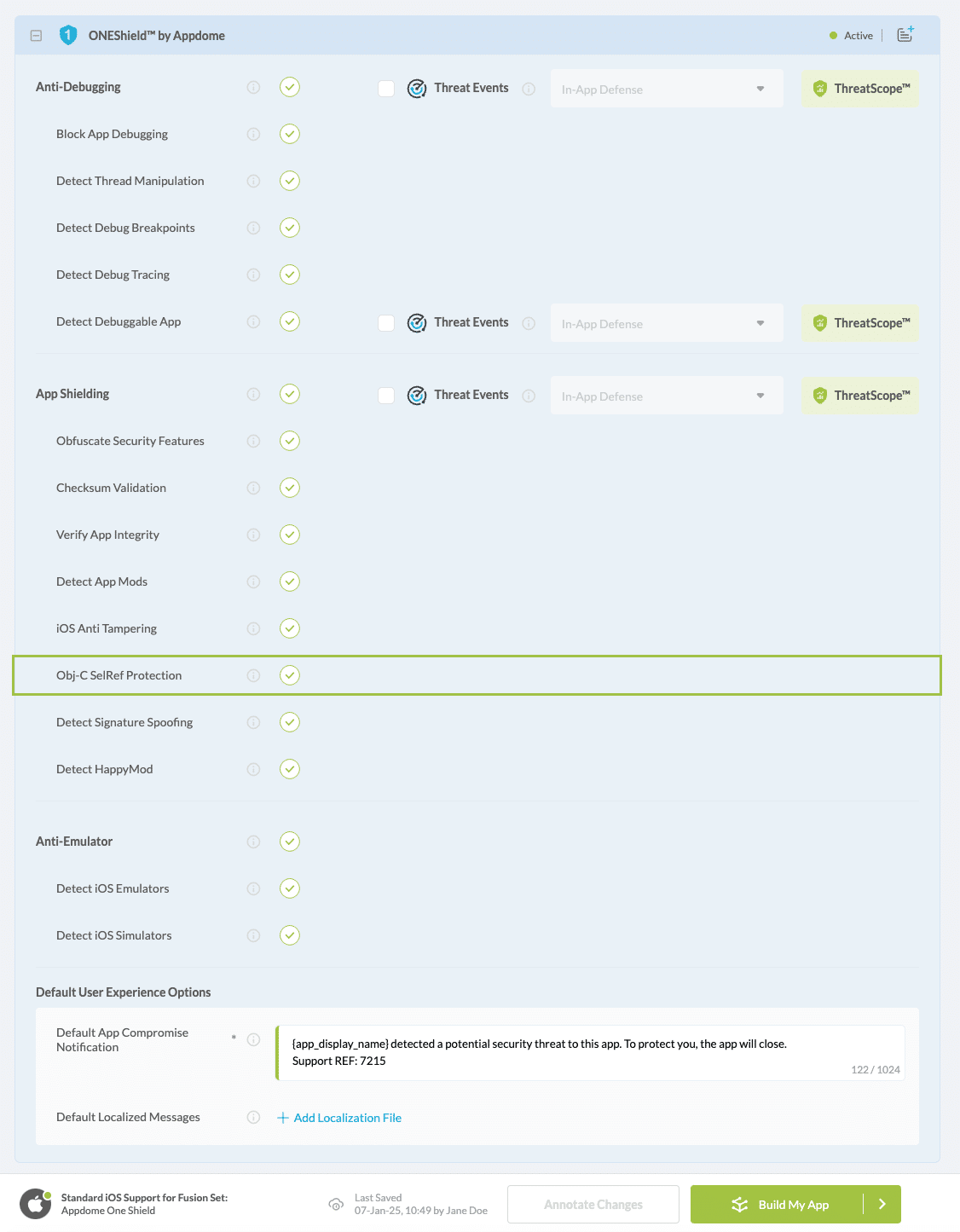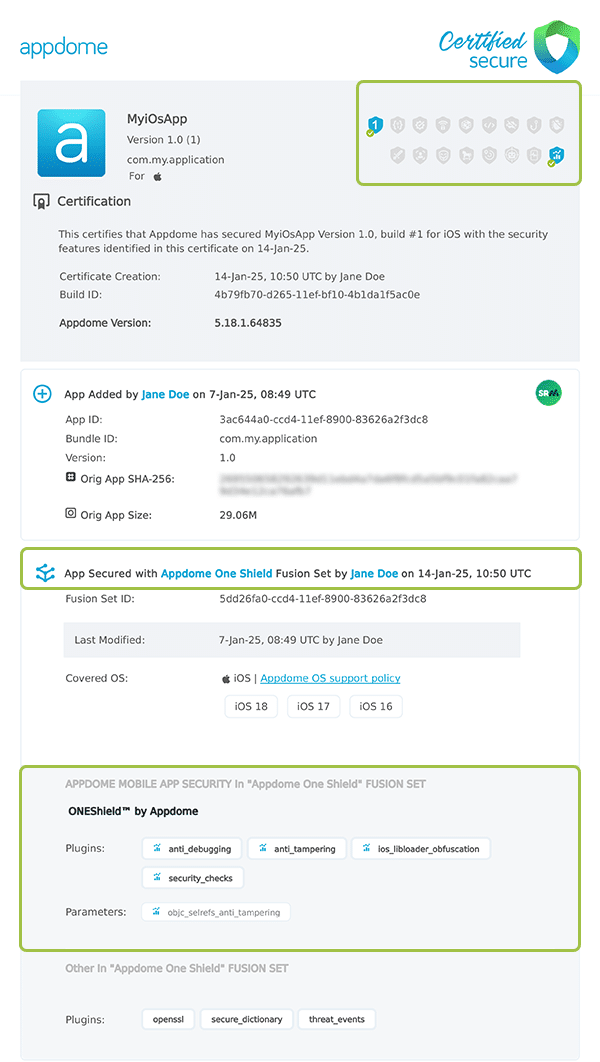How to Protect Obj-C SelRefs Against Tampering Apps Using AI
This Knowledge Base article describes how to use Appdome’s AI/ML in your CI/CD pipeline to continuously deliver plugins that Protect Obj-C SelRef in iOS apps.
What Are Objective-C SelRefs in iOS Apps?
In Objective-C applications, selectors (SelRefs) are used to reference methods dynamically at runtime. These selectors are stored in a global table within the Mach-O file and can be accessed or modified externally, exposing them to tampering and manipulation. Attackers can target this structure to modify or redirect function calls, potentially hijacking the app’s behavior. For instance, by modifying selectors, hackers can change the intended method or function execution, compromising app security and leading to potential vulnerabilities such as code injection or unauthorized execution of malicious code. Protecting SelRefs is essential to prevent unauthorized method manipulation, securing the app’s internal logic, and supporting regulatory requirements like PCI-DSS.
How Appdome Protects Objective-C SelRefs Against Tampering?
Appdome’s dynamic Obj-C SelRef Protection plugin for iOS defends against tampering with the global selector table in Objective-C applications. The plugin continuously monitors the selector table for unauthorized changes, preventing manipulation of method references. If an attempt is made to modify or replace a method’s selector, the app is immediately shut down to prevent further damage. This protection is essential for stopping reverse-engineering efforts, ensuring accurate method references, and blocking attackers from hijacking method calls for malicious actions.
Prerequisites for Using Appdome's Obj-C SelRef Protection Plugins:
To use Appdome’s mobile app security build system to Protect Obj-C SelRef , you’ll need:
Appdome account (create a free Appdome account here)
A license for ONEShield™
Mobile App (.ipa for iOS)
Signing Credentials (see Signing Secure Android apps and Signing Secure iOS apps)
How to Implement Protect Obj-C SelRef in iOS Apps Using Appdome
On Appdome, follow these 3 simple steps to create self-defending iOS Apps that Protect Obj-C SelRef without an SDK or gateway:
-
Designate the Mobile App to be protected.
-
Upload an app via the Appdome Mobile Defense platform GUI or via Appdome’s DEV-API or CI/CD Plugins.
-
iOS Formats: .ipa
-
Obj-C SelRef Protection is compatible with: Obj-C, Java, Swift, Flutter, React Native, Unity, Xamarin, Cordova and other iOS apps.
-
-
Select the defense: Obj-C SelRef Protection.
-
-
Follow the steps in Sections 2.2-2.2.2 of this article to add the Obj-C SelRef Protection feature to your Fusion Set via the Appdome Console.
-
When you select the Obj-C SelRef Protection you'll notice that the Fusion Set you created in step 2.1 now bears the icon of the protection category that contains Obj-C SelRef Protection.

Figure 2: Fusion Set that displays the newly added Obj-C SelRef Protection protection
Note: Annotating the Fusion Set to identify the protection(s) selected is optional only (not mandatory). -
Open the Fusion Set Detail Summary by clicking the “...” symbol on the far-right corner of the Fusion Set. Copy the Fusion Set ID from the Fusion Set Detail Summary (as shown below):

Figure 3: Fusion Set Detail Summary
-
Follow the instructions below to use the Fusion Set ID inside any standard mobile DevOps or CI/CD toolkit like Bitrise, Jenkins, Travis, Team City, Circle CI or other system:
-
Refer to the Appdome API Reference Guide for API building instructions.
-
Look for sample APIs in Appdome’s GitHub Repository.
-
Create and name the Fusion Set (security template) that will contain the Obj-C SelRef Protection feature as shown below:
Figure 1: Fusion Set that will contain the Obj-C SelRef Protection feature
-
-
Add the Obj-C SelRef Protection feature to your security template.
-
Navigate to Build > Security tab > ONEShield™ section in the Appdome Console.Like all other options in ONEShield™, Obj-C SelRef Protection is turned on by default, as shown below:

Figure 4: Selecting Obj-C SelRef Protection
Note: The App Compromise Notification contains an easy to follow default remediation path for the mobile app end user. You can customize this message as required to achieve brand specific support, workflow or other messaging.
-
Congratulations! The Obj-C SelRef Protection protection is now added to the mobile app -
-
Certify the Obj-C SelRef Protection feature in iOS Apps
After building Obj-C SelRef Protection, Appdome generates a Certified Secure™ certificate to guarantee that the Obj-C SelRef Protection protection has been added and is protecting the app. To verify that the Obj-C SelRef Protection protection has been added to the mobile app, locate the protection in the Certified Secure™ certificate as shown below:

Figure 5: Certified Secure™ certificate
Each Certified Secure™ certificate provides DevOps and DevSecOps organizations the entire workflow summary, audit trail of each build, and proof of protection that Obj-C SelRef Protection has been added to each iOS app. Certified Secure provides instant and in-line DevSecOps compliance certification that Obj-C SelRef Protection and other mobile app security features are in each build of the mobile app.
Using Appdome, there are no development or coding prerequisites to build secured iOS Apps by using Obj-C SelRef Protection. There is no SDK and no library to code or implement in the app and no gateway to deploy in your network. All protections are built into each app and the resulting app is self-defending and self-protecting.
Releasing and Publishing Mobile Apps with Obj-C SelRef Protection
After successfully securing your app by using Appdome, there are several available options to complete your project, depending on your app lifecycle or workflow. These include:
- Customizing, Configuring & Branding Secure Mobile Apps.
- Deploying/Publishing Secure mobile apps to Public or Private app stores.
- Releasing Secured Android & iOS Apps built on Appdome.
Related Articles:
How to Prevent Code Tampering in Android Apps
How to Prevent Code Tampering in iOS Apps
How to Automatically Validate Android and iOS App Logic & File Structure in CI/CD
How to Obfuscate Security Features on Appdome
How Do I Learn More?
If you have any questions, please send them our way at support.appdome.com or via the chat window on the Appdome platform.
Thank you!
Thanks for visiting Appdome! Our mission is to secure every app on the planet by making mobile app security easy. We hope we’re living up to the mission with your project.
